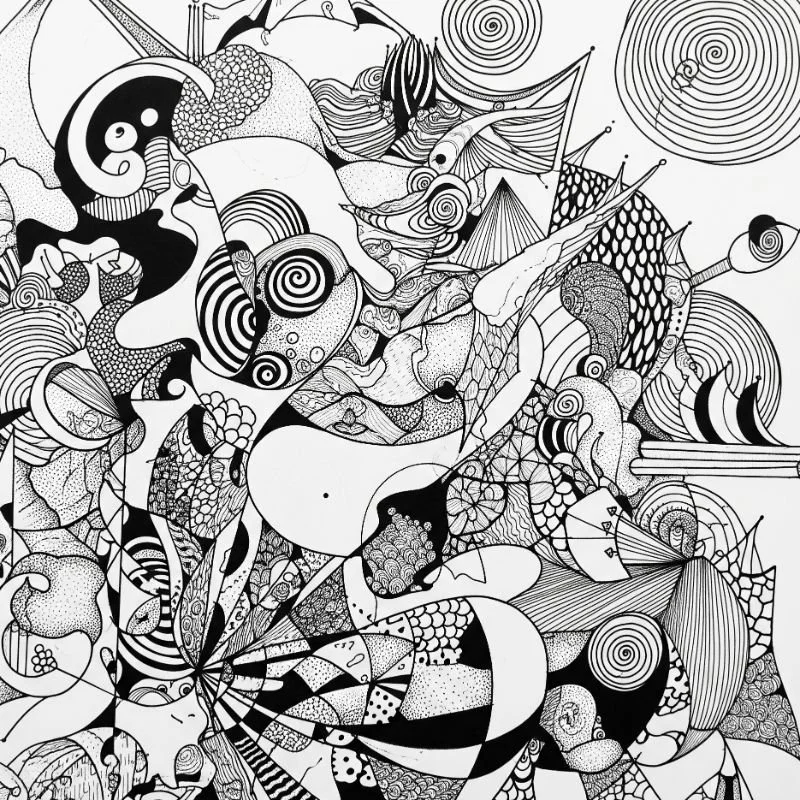How to Start Drawing Even If You’re a Complete Beginner
Discover how to start drawing today! Easy techniques, must-have supplies, and confidence tips for absolute beginners. No talent required!
Oh boy, here we go again! You're staring at that blank piece of paper, pencil trembling in your hand, thinking "What on earth have I gotten myself into?" Well, buckle up, buttercup, because I'm about to blow your mind: everyone, and I mean everyone, can learn to draw. Yep, even you with your stick figures that look like they've been through a blender! Learning how to start drawing even if you're a complete beginner isn't some mystical journey reserved for the "gifted" few. Nope, it's more like learning to ride a bike, except with less falling and more erasing. So, ready to ditch those excuses and dive into the wonderful world of drawing?
Breaking Down the "I Can't Draw" Myth
Let's get real for a second. You know that voice in your head saying you can't draw? Yeah, that one needs to zip it! Here's the thing: drawing is a skill, not some magical talent bestowed upon chosen ones at birth. Think about it, when was the last time a baby popped out holding a perfectly rendered portrait?
Walking down memory lane, remember when you couldn't tie your shoes? Or when typing felt like trying to play piano with boxing gloves on? But look at you now! Drawing works the same way. It's all about practice, patience, and a healthy dose of "who cares if it looks wonky?"
The biggest roadblock? Fear of judgment. But guess what? Every artist you admire once drew terrible stick figures too. They just kept going when others stopped. The difference between someone who can draw and someone who can't is simply that one of them didn't quit.
Essential Drawing Supplies (Without Breaking the Bank!)
Alright, before you go crazy at the art store like a kid in a candy shop, let's talk essentials. You don't need to sell a kidney to start drawing!
The Absolute Basics You Need
Pencils: Just grab a regular HB and a 2B pencil to start
Paper: Honestly? Printer paper works fine for practice
Eraser: Any eraser will do, but kneaded erasers are pretty neat
Sharpener: Because drawing with a dull pencil is like eating soup with a fork
The "Nice to Have" List
Sketchbook: For when inspiration strikes at weird times
Blending stumps: Fancy name for "things that smudge stuff nicely"
Pencil set (2H to 6B): When you're ready to get serious
Drawing board: Keeps your paper from doing the wiggle dance
Here's a pro tip: raid your house first! Got pencils from that conference you attended three years ago? Perfect! Old notebooks with blank pages? Jackpot! Starting doesn't require fancy equipment, just determination and something to make marks with.
How to Start Drawing Even If You're a Complete Beginner: Your First Baby Steps
Okay, you've got your supplies. Now what? Time to make some marks! But wait, not just any marks. Let's be strategic about this whole thing.
Warming Up Your Drawing Muscles
First things first, loosen up! Spend five minutes just making random marks. Circles, spirals, zigzags, whatever floats your boat. This isn't about making art; it's about getting comfortable holding the pencil. Think of it as stretching before a workout, except less sweaty.
The Shape Game
Everything, and I mean everything, can be broken down into basic shapes. That scary portrait? Just a bunch of circles and triangles having a party. Start with these fundamental shapes:
Circles: Try drawing them in one smooth motion
Squares: Aim for even sides (ish)
Triangles: Three sides, infinite possibilities
Rectangles: Squares' stretched-out cousins
Practice these until your hand stops shaking like a chihuahua in winter. Remember, perfection isn't the goal here. Progress is!
Line Confidence Building
Lines are like the alphabet of drawing. Master these bad boys:
Straight lines (harder than they look!)
Curved lines (embrace the wobbles)
Parallel lines (they're supposed to be friends, not lovers)
Cross-hatching (fancy word for lines that cross)
Fundamental Techniques That'll Make You Look Like a Pro
Now we're cooking with gas! Let's dive into some techniques that'll transform your doodles into actual drawings.
Understanding Light and Shadow
Light and shadow are what make a circle look like a ball instead of a flat pancake. Here's the secret sauce:
Pick a light source (imagine a lamp shining on your object)
The side facing the light? That's your highlight
The opposite side? Hello, shadow!
Blend between them for that smooth transition
Boom! You've just created three-dimensional magic on a flat surface. Mind blown yet?
The Art of Observation
Drawing is 80% looking and 20% doing. Seriously! Most beginners spend too much time staring at their paper instead of what they're drawing. Flip that ratio! Look at your subject like you're trying to memorize it for a test.
Notice things like:
Where lines actually start and end
How shapes connect to each other
The real proportions (not what your brain thinks they should be)
Subtle value changes
Texture Techniques
Want to make things look touchable? Texture is your friend! Different mark-making creates different surfaces:
Short, choppy lines = rough texture
Smooth, blended areas = soft surfaces
Dots and stippling = grainy textures
Scribbles = fuzzy or hairy surfaces
Practice Exercises for Building Skills
Practice without purpose is just doodling (which is fun, but we're trying to level up here!). Try these targeted exercises:
The Daily Object Challenge
Every day, draw one object from your surroundings. Monday might be your coffee mug, Tuesday could be that plant you keep forgetting to water. The key? Actually finish each drawing, even if it looks like it was drawn by a caffeinated squirrel.
Blind Contour Bonanza
This one's a riot! Look at an object and draw it without looking at your paper. Not even a peek! Yes, it'll look absolutely bonkers, but it trains your hand-eye coordination like nobody's business.
The Five-Minute Sprint
Set a timer for five minutes and draw as much detail as you can. When time's up, stop! This prevents overworking and teaches you to capture the essence quickly.
Copy the Masters (Legally!)
Find simple drawings online or in books and copy them. This isn't cheating; it's learning! You're training your hand to create specific shapes and understanding how other artists solve visual problems.
Common Pitfalls and How to Dodge Them
Learning how to start drawing even if you're a complete beginner means knowing what traps to avoid. Here are the biggies:
The Perfectionism Trap
Trying to make every line perfect will drive you bananas. Embrace the wonky lines! They add character. Besides, there's no such thing as a perfect drawing, only finished ones.
The Comparison Game
Oh boy, this one's a doozy. Comparing your day-one drawings to someone's year-ten masterpieces? That's like comparing a seedling to an oak tree. Stay in your lane and focus on your own growth.
Information Overload
With the internet, it's easy to bounce from tutorial to tutorial without actually practicing. Pick one approach and stick with it for at least a month before trying something new.
Skipping the Basics
Everyone wants to draw portraits or dragons right away. But trying to run before you can walk? Recipe for frustration soup! Master those basic shapes first.
Building a Sustainable Drawing Habit
Consistency beats intensity every single time. Here's how to make drawing stick:
The Two-Minute Miracle
Can't find time? Start with just two minutes daily. That's less time than brushing your teeth! Once you start, you'll often keep going, but even if you don't, you've maintained the habit.
Create Your Drawing Sanctuary
Set up a dedicated drawing spot. Doesn't have to be fancy! A corner of your desk with supplies ready to go works perfectly. When everything's set up, you're more likely to actually use it.
Track Your Progress
Keep all your drawings, even the cringe-worthy ones. Date them! In a few months, you'll be amazed at how far you've come. Those "terrible" early drawings? They're proof of your journey.
Find Your Tribe
Join online communities or local drawing groups. Having people to share your work with (and commiserate over stubborn drawings) makes the journey way more fun.
Resources to Accelerate Your Learning
The internet is bursting with drawing resources. Here are the cream of the crop:
Free Online Goodies
YouTube tutorials (literally millions of 'em)
Pinterest for reference images
Free courses on Skillshare and Coursera
Instagram artists sharing their process
Books That Actually Help
"Drawing on the Right Side of the Brain" (classic for a reason)
"Keys to Drawing" (practical exercises galore)
"Figure Drawing for All It's Worth" (when you're ready to level up)
Apps and Digital Tools
Procreate (iPad users, rejoice!)
Concepts (great for beginners)
Adobe Fresco (free with limited features)
Making Art a Part of Your Life
Drawing isn't just about creating pretty pictures. It's about seeing the world differently, expressing yourself, and having a blast while doing it. Here's how to weave it into your daily life:
Morning Sketch Sessions
Start your day with a quick sketch. Even just five minutes of drawing with your morning coffee can set a creative tone for the whole day.
Carry a Pocket Sketchbook
Waiting in line? Sketch! Boring meeting? Doodle in the margins! Every moment is a potential drawing opportunity.
Theme Weeks
Dedicate each week to a different subject. "Tree week," "hand week," "coffee cup week." This focused practice accelerates improvement in specific areas.
Conclusion
So there you have it! Learning how to start drawing even if you're a complete beginner isn't rocket science. It's about picking up that pencil, making marks, and enjoying the ride. Remember, every amazing artist started exactly where you are now. The only difference? They kept going. So grab that pencil and start your artistic adventure today!
FAQs
1. How long will it take before my drawings look good?
With daily practice, you'll see improvement within weeks. Good is subjective, though!
2. Do I need natural talent to learn drawing?
Nope! Drawing is a learnable skill. Persistence beats talent every single time here.
3. Should I start with digital or traditional drawing?
Traditional is cheaper and teaches fundamentals better. Digital can come later if desired.
4. What's the best subject to draw as a beginner?
Simple objects like fruit, basic shapes, or household items work perfectly for starters.
5. How do I know if I'm improving?
Keep old drawings to compare. Progress is often gradual but definitely there!


































